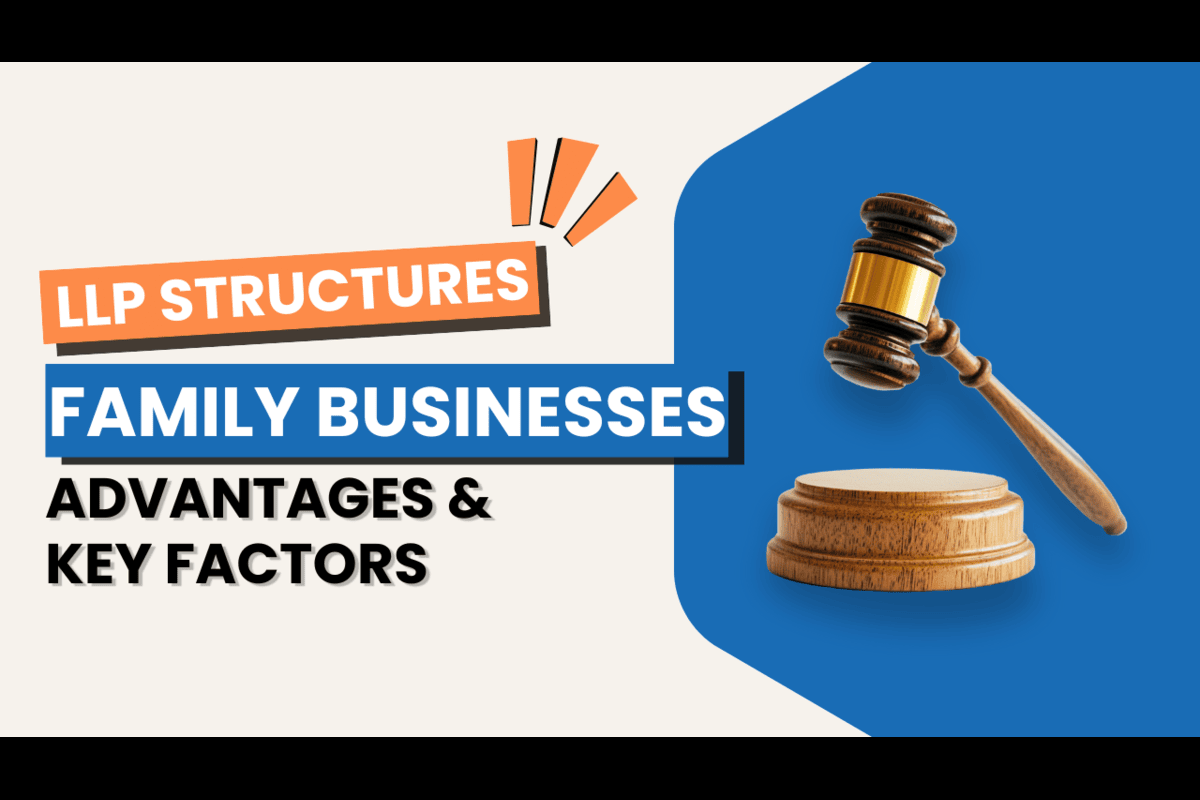
LLP Structures for Family Businesses: Advantages & Key Factors
- Book My Author
- Business
- 2025-10-01 17:36:06
- 1007K
Family businesses form the backbone of the Indian economy, contributing to employment, wealth creation, and social upliftment. Choosing the right organizational forms remains one of the biggest challenges faced by family-owned businesses in balancing control, flexibility, and protection from liabilities.
While traditionally common are partnership firms and private limited companies, family businesses are now increasingly looking at Limited Liability Partnerships as a better alternative. An LLP embodies all the simple features of a partnership while offering all the protective features of a company, thereby making it highly attractive for family-run businesses.
This blog explores the reasons LLPs are becoming popular for family businesses, along with the salient features of LLPs and important points to consider before deciding on this structure.
What is a Limited Liability Partnership (LLP)?
An LLP is a hybrid business structure that merges the features of a traditional partnership with those of a private limited company. Introduced in India under the Limited Liability Partnership Act, 2008, LLPs are governed by a mix of partnership and company laws.
Key characteristics include:
- Separate legal entity status
- Perpetual succession, even if partners change
- Limited liability for partners (personal assets are generally protected)
- Fewer compliance requirements than a company
For family businesses, these features mean that members can run the business together while ensuring that individual risks are minimized.
Why LLPs Suit Family Businesses
Family businesses often involve multiple generations, varying skill sets, and overlapping ownership interests. Unlike sole proprietorships or informal partnerships, an LLP allows for:
- Clear division of responsibilities
- Protection of personal wealth
- Professional yet flexible management
- A balance between tradition and modern governance
This makes LLPs particularly appealing to families who want to safeguard their legacy while adapting to today’s regulatory and business environment.
Advantages of LLP Structures for Family Businesses
1. Limited Liability Protection
In a traditional partnership, each partner is personally liable for the debts of the firm. In an LLP, liability is restricted to the agreed contribution. This ensures that family members’ personal wealth, such as homes and savings, is not at risk in case the business faces losses or legal claims.
2. Separate Legal Identity
An LLP is treated as a separate legal entity distinct from its partners. This means the LLP can own assets, enter into contracts, or sue and be sued in its own name. For family businesses, this separation helps maintain clarity between business assets and family assets.
3. Flexible Ownership and Management
Family members can be admitted as partners with clear roles defined in the LLP agreement. Unlike a company, where directors have statutory obligations, LLPs allow flexibility in decision-making and profit-sharing ratios. This is especially useful in a family setup where different members may contribute differently in terms of capital, expertise, or time.
4. Ease of Succession Planning
Family businesses often struggle with succession issues when ownership transitions from one generation to another. With an LLP, new members can be added or existing partners can exit without disturbing the continuity of the business. This makes generational transfer smoother.
5. Tax Efficiency
LLPs are not subject to dividend distribution tax (DDT), which applies to companies. Profits are taxed only once at the LLP level, and partners are taxed individually on their share of income. This avoids the double taxation faced by private limited companies, making LLPs more tax-efficient.
6. Lower Compliance Burden
Compared to private limited companies, LLPs have fewer compliance requirements. For example:
- No mandatory audits unless turnover exceeds ₹40 lakhs or contribution exceeds ₹25 lakhs
- No requirement of board meetings or annual general meetings
- Simplified filing of annual returns
For small to medium-sized family businesses, this translates into lower costs and less administrative work.
7. Flexibility in Profit Sharing
In partnerships and LLPs, the profit-sharing ratio does not need to match the capital contribution. Families can structure profit-sharing based on contribution, involvement, or agreed terms, offering greater fairness and customization.
8. Good Balance Between Control and Transparency
LLPs allow families to retain control while operating with formal agreements and statutory recognition. This balance builds trust among family members and outside stakeholders such as banks, vendors, or investors.
Key Factors to Consider Before Choosing LLP for a Family Business
While LLPs bring many advantages, they may not always be the perfect fit for every family-owned business. Here are the crucial factors you should evaluate before making a decision:
1. Size and Nature of Business
LLPs will be more suitable for small and medium family enterprises operating in professional services, consulting, trading, or manufacturing. If, however, the family business wants to raise significant amounts of outside investment or go public, then the private limited company structure would work better.
2. Number of Family Members Involved
The LLP Act requires a minimum of two partners but does not provide for an upper limit. Families with a higher number of stakeholders should draft the LLP agreement very carefully to avoid any conflicts regarding roles, responsibilities, and profit-sharing.
3. Succession and Exit Claws
Succession must be planned well in advance. In the LLP agreement, the procedure for retirement, transfer of ownership, or entry of new family members should be clearly spelled out; otherwise, disputes might occur during the transition from one generation to another.
4. Capital and Liability Contribution
The capital contributed by each partner and his liability need to be stated in the LLP agreement. Disagreements can arise when certain partners contribute more capital than others, especially when no proper record or agreement has been made.
5. Tax Planning
An LLP offers certain tax advantages not available to companies, but every family situation is unique. It is best to take tax advice to be sure of aligning the LLP structure with other financial and estate planning requirements of the family.
6. Compliance and Reporting
While LLPs require fewer compliances, they must file annual returns with the Ministry of Corporate Affairs (MCA) as registered entities. Families need to be prepared for these compliances to keep the LLP legally functional.
7. Dispute Resolution Mechanisms
Conflict arises in family businesses because of interlacing personal and professional interests. It is thus imperative to provide for strong dispute resolution mechanisms in the LLP agreement. Arbitration, mediation, or third-party resolution may be considered.
8. Professionalism vs. Informality
An LLP is more structured than a partnership but is less formal than a company. The family must be comfortable with this balance. If they want something purely informal, then a simple partnership may suffice. For formal governance and large-scale funding, maybe a company structure would be better.
LLP vs Other Structures for Family Businesses
| Factor | Partnership Firm | LLP | Private Limited Company |
| Legal Entity | Not separate | Separate legal entity | Separate legal entity |
| Liability | Unlimited | Limited to contribution | Limited to shares |
| Compliance | Minimal | Moderate | High |
| Taxation | Single-level, but no benefits | Single-level, no DDT | Double taxation (Company + Dividend) |
| Succession | Can dissolve with partner exit | Smooth transfer possible | Smooth, with share transfer |
| Investment Attractiveness | Low | Moderate | High |
This table shows that LLPs strike a middle ground, making them ideal for family businesses that want balance without the heavy compliance of a private limited company.
Practical Tips for Setting Up an LLP for a Family Business
- Draft a Firm LLP Agreement - Clearly state roles and responsibilities, profit-sharing arrangement, and succession terms.
- Keep Family and Business Finance Separate - Have separate bank accounts for the LLP and accounting records.
- Always Engage the Best Professionals - Chartered accountants and legal advisors will ensure proper compliance.
- Plan Ahead for Growth - LLPs work well for the small to mid-sized family businesses; however, the future might involve scaling up and converting into a private limited.
- Practice Transparency - Regular meetings with open communication between the family partners will lead to trust and prevent conflicts.
Conclusion
Choosing an apt structure becomes imperative in any family business. Offering a unique balance of flexibility, liability protection, and tax efficiency, an LLP is found to be one of the most practical forms for family-owned enterprises in India. By means of protecting personal assets, allowing for smooth succession, and having certain compliance requirements that are simpler than others, LLPs become a vehicle for the family to protect its legacy while also operating in a professional setup recognised by law.
That said, every family business is a world in itself. One needs to consider his or her business factors before settling upon a particular structure, such as size, capital requirements, and long-term objectives. When acted upon concomitantly with proper planning and advice, an LLP Registration can truly provide for the perfect base on which the family business can stand tall and flourish through generations.










